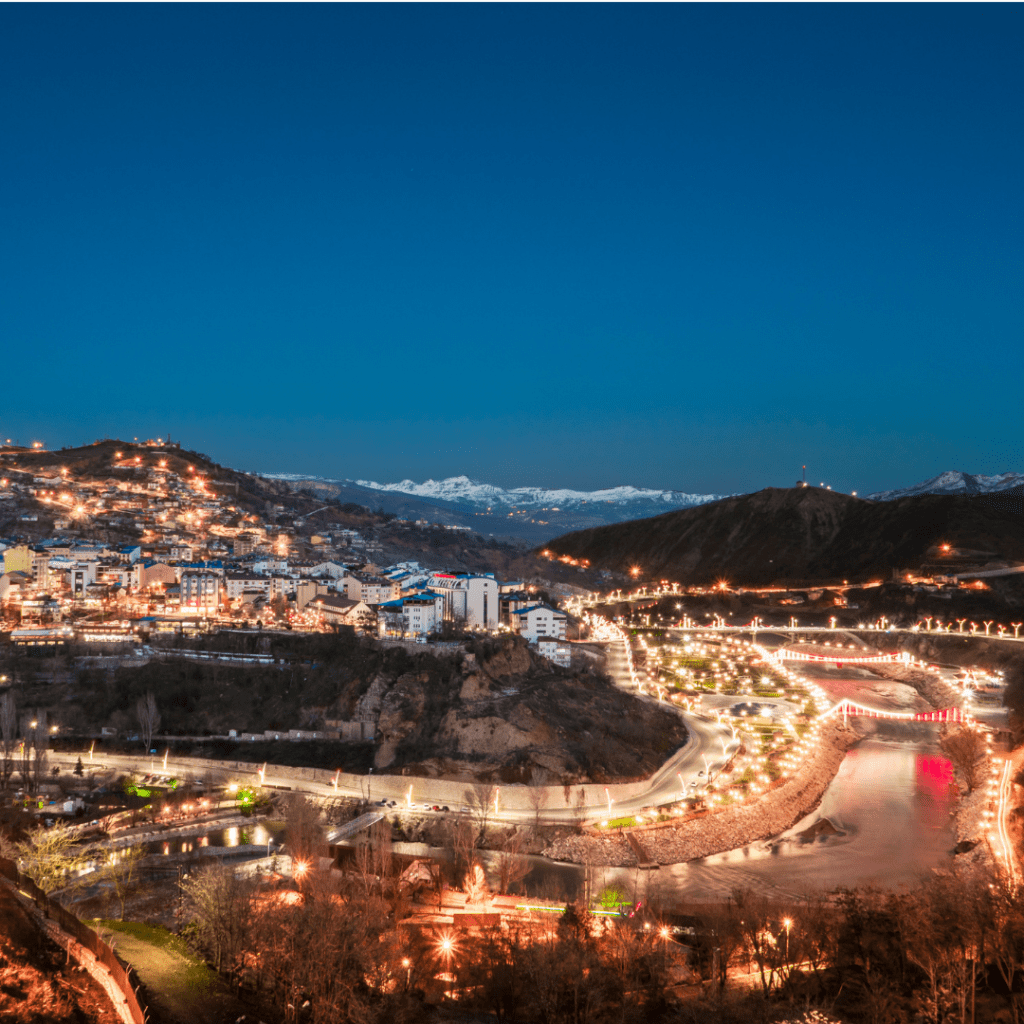Impressions from Tunceli Part I: A City Caught between Perception and Reality – Mehmet Öğütçü

I had received a somewhat chilling invitation to speak on the international dimensions of local development from the Rector of Munzur University and the regional development agency. I accepted without hesitation, feeling a mixture of excitement and curiosity. I was going to visit Tunceli for the first time. The questions swirling in my mind reflected some harsh realities about the region and certain innocent concerns related to unfamiliar geography, including security.
Thanks to three dear friends, Sanford Henry, Cumhur Doğan, and Orhan Karal, who accompanying me on this trip, we explored Tunceli and its surroundings together.
For those who have never seen it, Tunceli can be associated with the Dersim uprisings, Şeyh Said, Zazas, Alevis, tribes, security risks, the late politician Kamer Genç, former CHP leader Kemal Kılıçdaroğlu, Türkiye’s only communist mayor Fatih Maçoğlu, and the sacred Munzur River. The city was known as Daranis and Derksene by Greek historians and geographers, and is situated in the Upper Euphrates region of Eastern Anatolia. Tunceli is surrounded by the Munzur Mountains and the Karasu River to the north and west, the Bingöl Mountains and the Peri River to the east, and the Keban Dam Lake to the south.
Like many places in Anatolia, this region has been home to many civilizations over the ages including Romans, Parthians, Cappadocians, Seleucids, Eastern Roman Empire, Byzantine, Sassanians, Seljuks and Ottomans.
Tunceli is often known for its natural beauty, but also boasts historical artifacts such as Pertek Castle, Tozkoparan Hoyuğu, Çelebi Ağa Mosque, Bride Chambers, Elti Hatun Tomb, and Rabat Bridge, which are all traces of different civilizations left in the region. In this column I wasn’t to share my impressions and observations about Tunceli city and its people.
Education is perceived almost as a form of worship here
The people who live in Tunceli understand the importance of education better than anyone. People of Tunceli rightly take pride in the literacy rates in the province. One interesting fact that piqued my curiosity: People of Tunceli highly values the quality of education, and they generally do not send their children to schools or universities in their own city if they can afford it. Instead, they send them to larger cities or even Western countries for education.
The population of the city center has declined significantly over the years, now standing at around 40,000. One-fourth of this population comprises students, faculty, and administrative staff of Munzur University. The security issues experienced in the 1980s and 1990s due to terrorist incidents have contributed to the population decline. These migrations have made Tunceli the province with the lowest population in Turkey today.
Girls are not married off at a young age in Tunceli. Those who attempt to marry them off are frowned upon and looked down upon. They are oppressed under the weight of “neighborhood peer pressure.” Our conversations with local people revealed that religious and traditional sentiments are not as strong as they were in previous generations, and young people in Tunceli have sharper views on the world’s events, the country’s future, ethnic and religious issues compared to their parents. One can sense a bitterness in their feelings towards Ankara and historical figures of the Republic. I heard criticisms of not being treated as equal citizens. I also encountered those who blame Atatürk and İnönü for the Dersim events, yet they do not hesitate to prominently display posters of Atatürk at home. They are particularly sensitive about secularism.
The Munzur River is sacred
Tunceli is located where the Munzur and Pülümür rivers meet.
Cities with rivers running through them thrive, generously providing their water to residents. Meanwhile, the turquoise-colored, crystal-clear Munzur flows on its own along the city’s edge towards Lake Keban. It seems disconnected from the city.
Munzur Valley became a national park in 1971, covering an area of 42,000 hectares between Tunceli and Ovacık. The park is rich in river sources, with 1518 plant species and 227 endemic plants, making it diverse in terms of flora and fauna. Notable species include the Can Flower, Erzincan Cherry, Binbirdelik Herb, Munzur Partridge, Munzur Wedding Flower, and Mountain Tea. In the Pülümür Valley, we bought the natural and unique Pülümür honey produced by bees from hundreds of flower varieties. We also enjoyed the unique beauty of the Nazımiye Dereova Waterfall and bought Savak tulum cheese.
Its association with Alevi belief adds a separate mystery, beauty, and nobility to the sanctity of Munzur River. Fatma Ana, located north of Tunceli on the Munzur River, is one of the most important pilgrimage sites. Hz. Fâtima-i Zehra, the youngest daughter of Prophet Muhammad. Prophet Muhammad married Fatima to Hz. Ali, whom he cherished and called “Ummu Ebiba,” meaning “Mother of her Father.” Before her death, Hz. Fatima left a will, asking for her funeral to be secretly buried at night. Because she had become estranged from those who hurt her and her family. Especially from Abu Bakr, the caliph of that period. She was so hurt and deeply estranged that she requested that forty symbolic graves be dug so that those who hurt her could not find her place.
Eye Springs
Ovacık is located 65 kilometers away from the center of Tunceli. It can be reached by passing through a narrow, green valley alongside the Munzur River. Ovacık, true to its name, is a small but fertile plain nestled against the Munzur and Mercan Mountains. There’s a liveliness here that you wouldn’t find in any other small town in Anatolia.
Walking to the Mercan springs, exploring the village cemeteries that preserve the Akkoyunlu tradition, searching for waterfalls, and then heading towards the Munzur springs, followed by visiting the Forty Stairs waterfalls, all make for an unforgettable experience.
Both Munzur and Mercan springs originate from points numbered around 40. In Tunceli, these sources are called “göze.” Water gushes out from between the rocks on the mountain slopes, forming large rivers. The Munzur springs serve as both a picnic area and a religious site. At the entrance to these springs, you can find wish candles being sold, prayers being offered, sacrifices being made, and vows being taken. Right next to them, you’ll also see picnickers enjoying themselves with rakı or wine.
Our Alevi brothers and sisters consider these springs to be religious sites and can sometimes feel uncomfortable with the relaxed behavior of picnickers who openly consume alcohol and barbecue next to the springs.
Lucky Mountain Goats of Tunceli
In Tunceli, according to the prevalent Alevi belief, mountain goats are considered sacred. Therefore, hunting them is prohibited by the unwritten rules of society. However, those who still hunt them are punished by unwritten rules as well. The punishment is administered by the “dede,” the religious leaders in the Alevi community.
Those who kill mountain goats are considered to have committed a sin and are labeled as “wanderers.” They are not accepted into religious gatherings, the cemevi, they are not taken in by the dede without repenting for their sins, and they are not allowed to kiss their hand. They become isolated and are expelled from society. They are told, “Why did you kill? What was your trouble? You have sheep at your door, go and slaughter them instead.”
They are considered the flock of saints like Sarık Zivam, Şeyh Ahmet Dede, Düzgün Baba, and Ana Fatma. They have given these sacred figures’ names so that no one would kill them.
No Dam on Munzur
Those enthusiastic about building hydroelectric power plants, especially upstream of Fatma Ana (Mother Fatma), have had their hopes dashed. “Even if Munzur flows with blood, the people will not allow it, they will not let anyone desecrate its sanctity,” they told us.
The governor has also grasped this strong sensitivity well and has been opposing hydroelectric power plant projects from day one. Similarly, those who come to search for mines in the mountains end up disappointed. While rich mines are exploited on the Erzincan side of the mountain, the people of Tunceli have not allowed anyone to approach their lands or mountains.
If there’s an electricity supply issue, right at the gateway to Elazığ, stands the magnificent Keban Dam. When it was built in 1975, it met 25% of Turkey’s electricity needs. Today that figure has dropped to 8%. Therefore, the required energy can easily be transmitted to Tunceli from here. Production costs in dammed hydroelectric power plants are very low. Of course, TEIAS (Turkish Electricity Transmission Corporation) needs to manage this with natural gas and coal power plants.
As we tour Keban, we immediately think of the late Süleyman Demirel, who was known as “the king of dams.” Keban was rightfully one of his most praised projects. I believe, out of respect, a statue of him should be erected on the dominant peak of Keban, so that he can forever gaze upon one of his masterpieces from above.
Before ending the first part of my travel blog I want to highlight an interesting fact: There are around one million people of Tunceli origin living in other parts of our country and abroad was surprising. It turns out that almost every household receives remittences from relatives living abroad. This is likely why we see traces of prosperity everywhere, with high real estate purchases and consumption expenditures. Due to the evacuation of villages in the past and insufficient job opportunities caused young people migrated elsewhere and the city lost its dynamism and energy.
Tunceli is located on the Erzincan-Elazığ highway, connecting the northern and southern parts of Eastern Anatolia. The distance between Tunceli and Trabzon is 358 kilometers, and the bus journey between the two cities takes 6 hours. If the road that will connect Tunceli to Trabzon is completed, the fate of Tunceli on the route connecting the Black Sea to the Mediterranean could fundamentally change. The nearest airport to Tunceli is Elazığ Airport, which is approximately 120 km away from the city center and serves domestic flights.
If transportation is accelerated and the roads are completed, it is highly likely that Tunceli will become a summer resort for Elazığ and Erzincan. Hopefully, a real rural development model will emerge before it turns into a concrete jungle.

Mehmet Öğütçü
Chairman, Global Resources Partners, UK, and The London Energy Club. Former diplomat, prime minister adviser, IEA and OECD senior executive, director and independent board member at British Gas, Genel Energy, Invensys, Şişecam, Yaşar Holding companies. Chairman of the Middle East Institute, Washington DC, Advisory Board. He can be contacted at [email protected]
To cite this work: Mehmet Öğütçü, “Impressions from Tunceli Part I: A City Caught between Perception and Reality”, Panorama, Online, 12 June 2024.
Copyright@UIKPanorama All on-line and print rights reserved. Opinions expressed in works published by the Panorama belongs to the authors alone unless otherwise stated, and do not imply endorsement by the IRCT, Global Academy, or the Editors/Editorial Board of Panorama.